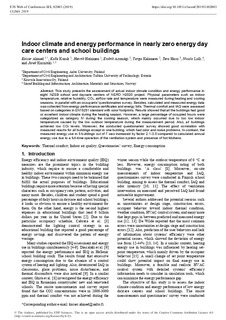Indoor climate and energy performance in nearly zero energy day care centers and school buildings
| dc.contributor.author | Ahmed, Kaiser | |
| dc.contributor.author | Kuusk, Kalle | |
| dc.contributor.author | Heininen, Henrik | |
| dc.contributor.author | Arumägi, Endrik | |
| dc.contributor.author | Kalamees, Targo | |
| dc.contributor.author | Hasu, Tero | |
| dc.contributor.author | Lolli, Nicola | |
| dc.contributor.author | Kurnitski, Jarek | |
| dc.date.accessioned | 2019-10-08T11:37:06Z | |
| dc.date.available | 2019-10-08T11:37:06Z | |
| dc.date.created | 2019-10-04T09:41:19Z | |
| dc.date.issued | 2019 | |
| dc.identifier.issn | 2267-1242 | |
| dc.identifier.uri | http://hdl.handle.net/11250/2620902 | |
| dc.description.abstract | This study presents the assessment of actual indoor climate condition and energy performance in eight NZEB school and daycare centers of NERO H2020 project. Physical parameters such as indoor temperature, relative humidity, CO2, airflow rate and temperature were measured during heating and cooling seasons, in parallel with an occupants’ questionnaires survey. Besides, calculated and measured energy data was collected from energy performance certificates and energy bills. Thermal comfort and IAQ were assessed based on categories in EN15251 standard with color footprints. Results showed that all the buildings had good or excellent indoor climate during the heating season. However, a large percentage of occupied hours were categorized as category IV during the cooling season, which mainly occurred due to too low indoor temperature caused by the low outdoor temperature during the measurement period. Also, all buildings achieved low CO2 levels. Moreover, the conducted questionaries’ survey showed good correlation with measured results for all buildings except in one building, which had odor and noise problems. In contrast, the measured energy use in 5 buildings out of 7 was increased by factor 2.1-3.0 compared to calculated annual energy use due to a full-time operation of the ventilation system and presence of hot kitchens. | nb_NO |
| dc.language.iso | eng | nb_NO |
| dc.publisher | EDP Science | nb_NO |
| dc.rights | CC BY 4.0 | * |
| dc.rights.uri | http://creativecommons.org/licenses/by-nc-nd/4.0/deed.no | * |
| dc.subject | Thermal comfort | nb_NO |
| dc.subject | Indoor air quality | nb_NO |
| dc.subject | Questionaries’ survey | nb_NO |
| dc.subject | Energy consumption | nb_NO |
| dc.title | Indoor climate and energy performance in nearly zero energy day care centers and school buildings | nb_NO |
| dc.type | Journal article | nb_NO |
| dc.type | Peer reviewed | nb_NO |
| dc.description.version | publishedVersion | nb_NO |
| dc.rights.holder | © 2019 The authors | nb_NO |
| dc.subject.nsi | VDP::Teknologi: 500 | nb_NO |
| dc.source.volume | 111 | nb_NO |
| dc.source.journal | E3S Web of Conferences | nb_NO |
| dc.identifier.doi | 10.1051/e3sconf/201911102003 | |
| dc.identifier.cristin | 1733822 | |
| dc.relation.project | EC/H2020/754177 | nb_NO |
| dc.relation.project | EC/H2020/754177 | nb_NO |
| cristin.unitcode | 7401,30,40,0 | |
| cristin.unitname | Arkitektur, byggematerialer og konstruksjoner | |
| cristin.ispublished | true | |
| cristin.fulltext | original | |
| cristin.qualitycode | 1 |
Tilhørende fil(er)
Denne innførselen finnes i følgende samling(er)
-
Publikasjoner fra CRIStin - SINTEF AS [5801]
-
SINTEF Community [2247]

